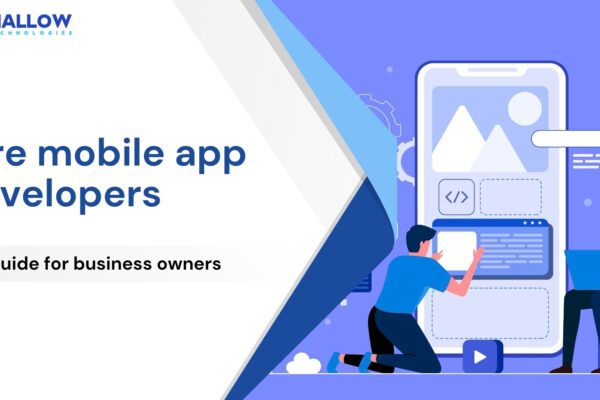There are a lot of reasons that could prevent you from making business decisions, especially when it comes to technology. Undoubtedly, the fear of not receiving a satisfactory return on your investment is high on the list.
We at Mallow have addressed this concern for many potential clients for over a decade, guiding them towards making the optimal choice.
We believe that every potential client who approaches us should have complete assurance of the outcome they can expect. This article presents a cost estimate for developing a Ruby on Rails application while partnering with a development team like Mallow.
What factors influence the cost of developing a Ruby on Rails application?
Types of resources
The roles of those working on your project are one of the most significant factors that impact the total cost of your development project. Essentially, your number of resources for each service type directly impacts your application development budget.
Enlisting specific resources to meet your needs may be necessary if you are considering establishing a development team. Below is a list of the different types of resources development projects use and when you might expect to need them.
- If you have decided to create a Ruby on Rails app, it is essential to have a developer on board. Depending on the requirements of your application, you may require both front-end and back-end developers to take care of UI and business logic.
- To ensure optimal performance and effective hosting of your Ruby on Rails application, it is highly recommended to include a resource from the DevOps team.
- If you’re experiencing a roadblock due to a lack of proper user experience in your app, it’s recommended to enlist the help of a design expert who can significantly enhance your application’s overall UI and UX.
- If you are seeking ways to enhance the overall quality of your application, it can make a significant difference to include experienced quality analysts in your team.
- If you require guidance on how to transform your business idea into an application, it is recommended that you involve business analysts in your development process. The pre-development phase of your application creation process involves extensive brainstorming, which includes deciding what problem the application is intended to solve and how, what functionalities it should possess, whether the end-user flow is logical, and so on.To ensure that these considerations are taken in the right direction, it is crucial to have a Business Analyst work in conjunction with your application development team to determine the best approach for achieving your goals.
- If you are seeking to ensure that your team works together towards a common goal by effectively managing resources, mitigating risks, and implementing efficient planning, it is highly recommended that you consider including a project manager.
You may be unsure about team building if it is something you have never done before. If you are suddenly tasked with assembling a team, you may wonder where to start, how to proceed, and when to stop.
Take a look at the table below, which provides an overview of the various types of resources and capabilities to consider before including them in your development team.
| Types of Resource | Capabilities |
| Developer |
|
| DevOps |
|
| Designer |
|
| Quality Analyst |
|
| Business Analyst |
|
| Project Manager |
|
Size of your development team
The number of team members should be proportional to the number of tasks to be completed. The size and number of teams you choose will directly impact the overall cost of your application development, so it’s important to choose efficiently. Plan ahead and allocate tasks carefully to determine the appropriate team size.
Avoiding frequent changes in team members can help maintain a smooth development process and prevent additional costs associated with knowledge transfer and other team procedural requirements. By minimising disruptions, you can save time and reduce expenses throughout the application’s development.
Below is a table that would give you a rough idea of how the size of your team should be based on the different types of tasks that development teams usually handle.
| Size of the team VS Capabilities | A Developer | 2-3 Developers | Squad – Includes 5-12 members | Multiple Squads |
| Minimal requirement (MVP) | ✔ | ✔ | Not Required | Not Required |
| Handling basic project complexities | ✔ | ✔ | Not Required | Not Required |
| Handling both frontend and backend dependencies | ✔ | ✔ | Not Required | Not Required |
| Implementing multiple features and integrations simultaneously | ✖ | ✔ | ✔ | Not Required |
| Maintenance of an application with medium-level complexity in features and architecture | ✖ | ✔ | ✔ | Not Required |
| Maintenance of an application with high-level complexity in features and architecture | ✖ | ✖ | ✔ | ✔ |
| Sharp Deadlines/Short- spanned deployments | ✖ | ✖ | ✔ | ✔ |
| Working on multiple tech stacks simultaneously | ✖ | ✖ | Sometimes not enough | ✔ |
| Carrying multiple modules in an enterprise-level application | ✖ | ✖ | ✖ | ✔ |
| Handling applications demanding multiple and complex integrations | ✖ | ✖ | ✖ | ✔ |
| Handling enterprise-level systems which involve microservices and serverless architectures | ✖ | ✖ | ✖ | ✔ |

Levels of expertise
Choosing the right combination of expertise for your application development team can significantly reduce your overall development cost.
Although it’s commonly believed that the more experienced the team members, the better the quality of work, this is not always the case, instead, you should focus on the skill sets of your team members to optimise your development process.
Not all tasks in the application development process require multiple team leads or associate team leads to work on them. Similarly, it’s not feasible to expect a junior developer to lead an entire team.
Therefore, it’s essential to categorise tasks based on the level of expertise required to complete them efficiently. By outlining your entire requirements and determining who will be responsible for what based on their expertise, you can ensure that your team is optimally utilised.
It’s understandable that your initial requirements may change as the process evolves, but having an initial work plan in place can help you avoid uncertainties.
The table below provides a rough idea of how the proficiency of a team member working in your team varies based on the level of expertise they possess.
| Levels of expertise | Details of the proficiency |
|---|---|
| Junior |
|
| Mid-level |
|
| Senior-level |
|
| Associate Team Lead |
|
| Team Lead |
|
How much do different resources cost for a Ruby on Rails project?
At this point, you’ve learned the available types of resources, their capabilities, the significance of selecting the appropriate expertise, and how to determine the ideal team size for your application development.

However, there is more to the process. The primary purpose of providing the information above is to highlight the “cost” associated with each expertise, which will impact your overall app development budget.
The table below provides a rough estimate of the cost of hiring a resource from a specific service based on their level of expertise.
The Monthly Cost (In USD)
| Types of resources | Junior | Mid Level-1 | Mid Level-2 | Mid Level-3 | Senior | Associate Team Lead |
|---|---|---|---|---|---|---|
| Developer | $2000.00 | $2400.00 | $2800.00 | $3200.00 | $4000.00 | $5000.00 |
| DevOps | $2000.00 | $2400.00 | $3200.00 | $3800.00 | $5000.00 | $6000.00 |
| Quality Analyst | $1200.00 | $1400.00 | $1800.00 | $2000.00 | $2800.00 | $3200.00 |
| Designer | $1200.00 | $1400.00 | $1800.00 | $2000.00 | $2800.00 | $3200.00 |
| Business Analyst | $1600.00 | $1800.00 | $2000.00 | $2400.00 | $3200.00 | – |
| Team lead | $6000.00 | |||||
| Technical Lead/ Technical Manager/ Project Manager |
$7000.00 | |||||
Does the development cost varies based on the complexity of the application?
Indeed, they do. To clarify, complexity is the fundamental factor determining your application development’s overall cost. Complexity refers to various aspects, such as the number of modules required, types of third-party integrations, business algorithms, application architecture and other related factors.
The following information outlines how you can expect the overall cost figures to appear when you view your entire project requirements.
| Levels of Complexity | Cost | Average Timeframe |
| Basic (MVP) | $20,000 – $40,000 | < 3 months |
| Average | $60,000 – $150,000 | 3 months – 9 months |
| Enterprise-level solutions | $200,000 – $1,000,000+ | > 6 months |
*It’s important to note that the above figures are intended to provide a rough estimate of the potential cost range. The estimated cost only includes the expenses related to the services mentioned. It does not account for additional costs such as hosting providers like AWS, Heroku, Azure and third-party services like SendGrid, Twilio, and others. Remember that the estimated figures may change depending on your specific project requirements.
Would Mallow Technologies be a suitable choice for developing my Ruby on Rails project?
While the information provided above is purely an estimation, it should provide you with valuable insights into how you can efficiently build your application development team.
Understanding each step in the team-building process can help you make informed decisions, ultimately leading to better outcomes. As you already know, web development frameworks have evolved significantly in recent years, and Ruby on Rails is a popular web development framework that needs no introduction.
Furthermore, the COVID-19 pandemic has underscored the significance of digitisation. After reviewing the cost details above, you should now have a rough estimate of how much it will cost to develop your Ruby on Rails application.
Interested in knowing more about whether your application would be a right fit for Mallow? Check out this blog that covers if your Ruby on Rails project is suitable to be developed by Mallow
If you have a business idea that you would like to collaborate on, please talk to one of our experts.
Your queries, our answers
No, Ruby on Rails is not a dying language. While newer frameworks have emerged, Ruby on Rails continues to be widely used, particularly for web applications that require rapid development and scalability. The community around Ruby on Rails remains active, and the framework is regularly updated with new features and security improvements. Check out here to know if Ruby on Rails is still relevant in 2025 and explore its current state and future prospects.
Mallow prioritizes security in every stage of development. We implement best practices like data encryption, secure authentication methods, and regular security audits. Ruby on Rails also has built-in security features, such as protection against SQL injection and cross-site scripting, which we utilize to safeguard your application.
The cost of building a Ruby on Rails application varies depending on the project's complexity, features, and scope. For a basic MVP, the cost ranges from $20,000 to $40,000 for a web app. For more complex applications, the cost can be significantly higher. We provide a detailed and transparent cost breakdown tailored to your specific requirements. Check out here to find out how much building a Ruby on Rails project with Mallow costs.
Yes, Mallow can integrate various third-party services, such as payment gateways, APIs, and external databases, into your Ruby on Rails application. Our team ensures seamless integration to enhance the functionality and user experience of your application.
Yes, we can align our working hours with your time zone to facilitate effective communication throughout the development process. Check out here to know how to handle the timezone difference.
Mallow offers the following outsourcing models: Project-based outsourcing, Staff augmentation, & Dedicated development team (DDT)
Ruby on Rails is a versatile framework that can be adapted to a wide range of projects. It excels in rapid development, making it suitable for startups, MVPs, and complex web applications. Whether you're building a large-scale e-commerce platform or a custom content management system, Ruby on Rails provides the flexibility and efficiency needed to support your project.
Mallow's development team is experienced in designing and implementing scalable Ruby on Rails applications. We use a combination of efficient code architecture, database optimization, and cloud infrastructure to ensure your application can scale to meet growing user demands without compromising performance.
The development timeline varies depending on the complexity and scope of the project. For a basic MVP, it might take around 3 to 6 months. More complex applications with advanced features could take longer. We work closely with you to establish a realistic timeline and keep you informed throughout the development process.
At Mallow, we emphasize thorough testing and quality assurance to ensure the reliability and performance of your Ruby on Rails application. Our QA team conducts various tests, including unit testing, integration testing, and end-to-end testing, to identify and fix issues before deployment.
No, we don’t provide off-the-shelf products. We are custom software solution providers who tailor applications in a customized way as you desire. However, we can create personalized applications tailored to your unique needs, providing you with a fully customized experience when using the application.
Yes, you can hire a dedicated Ruby on Rails developer or a team of developers from Mallow. This allows you to have a dedicated resource working exclusively on your project, providing more control and flexibility over the development process. Check out our article on the top 9 things to consider as you plan to hire a Ruby on Rails developer for more insights.
Author
SathishPrabhu
Sathish is an accomplished Project Manager at Mallow, leveraging his exceptional business analysis skills to drive success. With over 8 years of experience in the field, he brings a wealth of expertise to his role, consistently delivering outstanding results. Known for his meticulous attention to detail and strategic thinking, Sathish has successfully spearheaded numerous projects, ensuring timely completion and exceeding client expectations. Outside of work, he cherishes his time with family, often seen embarking on exciting travels together.



